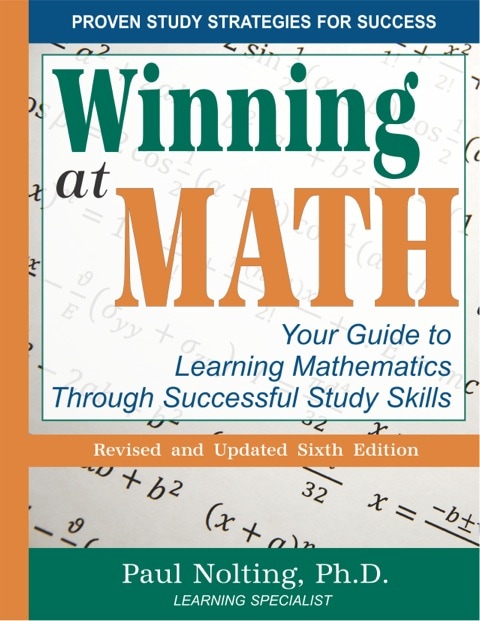Dr. Paul Nolting's Academic Success Press Blog: A Publication Dedicated to Math Success |
DR. PAUL NOLTING'S ACADEMIC SUCCESS PRESS BLOG
|
Post Author: Kim Nolting
As with many psychological and social constructs, the construct of mindfulness is often described differently once it becomes operationalized into a specific context, in our case during the first five minutes of class into the learning and teaching process. Brown and Ryan provide an overview of mindfulness in their introduction which is detailed enough to understand and apply to teaching and learning. Their research design, on the other hand, was detailed with five different studies. If interested, spend a little time and read each one. Brown, Warren K., and Ryan, Richard M. (2003). The benefits of being present: Mindfulness and its role in psychological well-being. Journal of Personality and Social Psychology 84 4 (822-848). Nature of Mindfulness The most common definition of Mindfulness is “the state of being attentive to and aware of what is taking place in the present" (Brown and Ryan, 2003). Awareness is the background “radar” that continually manages the inner and outer environments. We can be aware, however, without focusing intently on a single aspect of the environment. Attention is focusing on a specific aspect or piece of the present environment. Brown and Ryan describe it as follows, “attention continually pulls ‘figures’ out of the ‘ground’ of awareness, holding them focally for varying lengths of time” (Brown & Ryan, 2003). Mindfulness is enhanced attention during which a person is capable of disallowing other distractors to interfere with focus. Brown and Ryan discuss several distractors which can turn mindfulness into mindlessness. First, rumination of past experiences and their emotions/thoughts can distract a person from focusing, attending to in a mindful manner. Second, anxieties or fantasies about the future also distract meaningful focus. Third, a person can have so many activities and tasks going on at one time that can detract from focus. Fourth, focus can be detracted when a person acts compulsively or automatically without thinking about the behavior. Fifth, sometimes a person refuses to attend and focus on the present environment because she wants to avoid any of the negative thoughts or emotions the present situation might evoke. Brown and Ryan clarify Mindfulness by relating it to another construct: emotional intelligence. Emotional intelligence includes “the perceptual clarity about one’s emotional states,” (Brown and Ryan, 2003). Part of learning how to keep the above detractors from interrupting mindfulness is the willingness to be aware of them. Mindfulness involves perceiving the stimuli in the environment as they are, without detractors misinterpreting them. A person who uses mindfulness is able to identify when emotions or thoughts begin to detract focus on the present and then interact with the emotions or thoughts in a way to remove them from the present environment. Brown and Ryan also discussed how this component of mindfulness is important for another vital skill for success, self-regulation, which relies on a person’s ability to be insightful regarding their own emotions and thoughts in order to evaluate the benefits of a behavior and then adjust if necessary. Among the many findings, Brown and Ryan were able to state that mindfulness, both trait and state, contribute to autonomy, defined here as “behavior that is fully endorsed by the self,” (2003). A person who is maturing in the art of mindfulness knows her values and interests and lives day-to-day based on these values; subsequently a person with identified values and interests can self-regulate behavior that meets personal goals. Brown and Ryan refer to other mindfulness literature which emphasizes the important of a person being non-judgmental of his emotions or thoughts when interacting with them with the purpose of putting them aside in order to focus in the presence as it is. Finally, Brown and Ryan state how mindfulness can be developed with practice, increasing the value of it. Kim Nolting’s Response While studying Brown and Ryan, I thought of past college students who constantly struggled. Their minds were their own worst enemies. For instance, rumination about negative experiences with math instructors, family criticism, self-criticism, embarrassment in front of peers, tunnel their way into their thoughts. These ruminations and worries about the future do not take place solely in the classroom or during tests. Students can ruminate and experience anxiety when they purchase their math books. The cashier can even evoke anxious thoughts when she tells math students not to write their names in the books in case they return them the next week. Students can get anxious when they receive an email from the instructor asking them to review the first chapter before classes begin because they should already know the information. During the first class, they can think destructively when they see that chapter one was just a review for most of the students but not for them. For some students, math anxiety creeps in by just opening the book to study. These ruminations and worries about the future can also trigger another detractor Brown and Ryan mentioned--avoidance behavior like procrastination. Who likes feeling anxious? Once a college counselor referred a seriously anxious student to me in order to help her with some assignments. She shook the entire time and struggled focusing because her anxiety was more than just an emotion. She had allowed it to become her state of being. We made some progress but not much since her anxiety was stealing energy from her working memory. Fortunately for her, our college had at least seven counselors and only about 700 students. A counselor was able to work with her throughout the semester. What about students who do not have the option of counselors on campus? What can we do as instructors who are not trained as counselors?
1 Comment
4/6/2019 12:18:19 pm
I was happy with the way Brown and Ryan explained this thing. It’s true that mindfulness is a state of being attentive with people and your environment. I believe that mindfulness is also an advantage for some people because they get the chance to catch information, regardless if it is directed to them or not. When you are aware of the things that are happening in your environment, you tend to have the right reaction for everything. Huge thanks for this article because I’ve learned a lot.
Reply
Leave a Reply. |
AuthorDr. Nolting is a national expert in assessing math learning problems, developing effective student learning strategies, assessing institutional variables that affect math success and math study skills. He is also an expert in helping students with disabilities and Wounded Warriors become successful in math. He now assists colleges and universities in redesigning their math courses to meet new curriculum requirements. He is the author of two math study skills texts: Winning at Math and My Math Success Plan. Blog HighlightsAmerican Mathematical Association of Two-Year Colleges presenter, Senior Lecturer-Modular Reader Contributions
|
Proudly powered by Weebly


 RSS Feed
RSS Feed